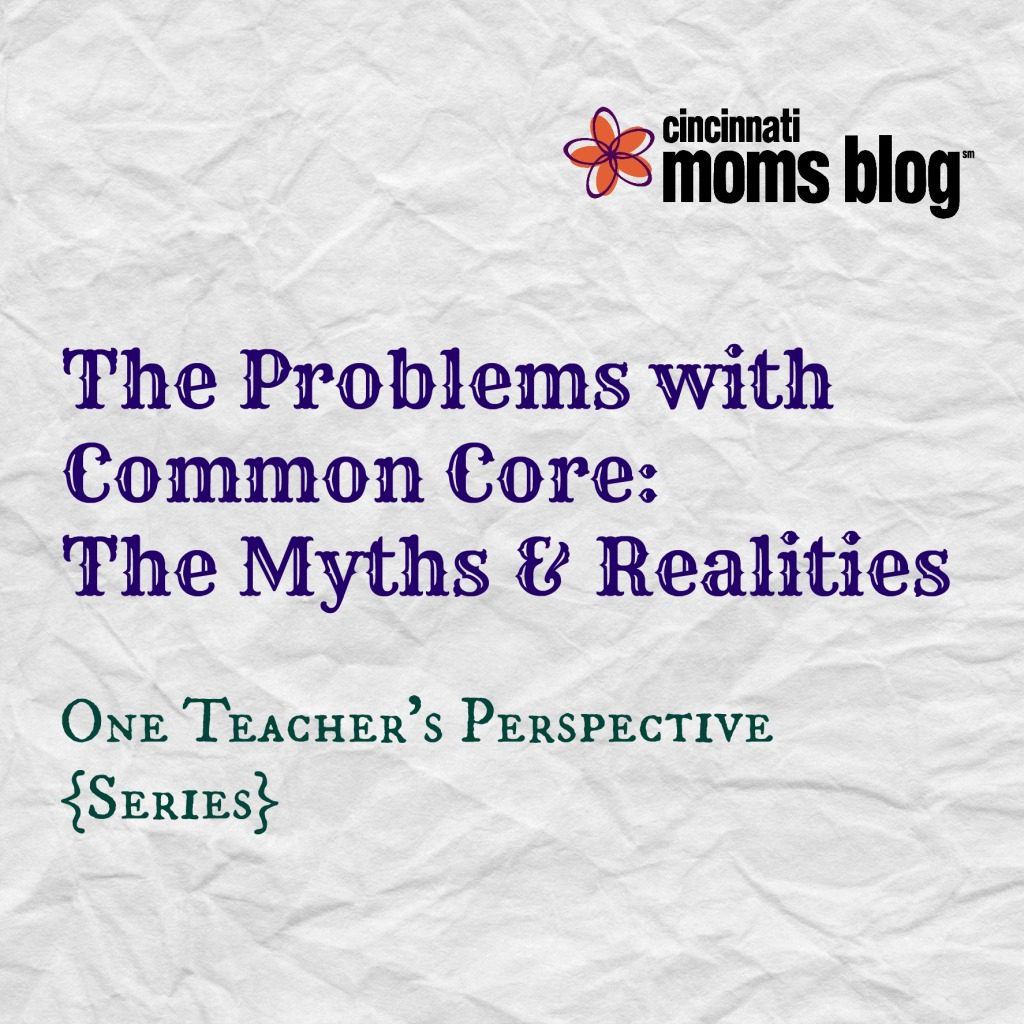We know that opinions and experiences with Common Core vary widely. In this series, our contributor is sharing his thoughts on Common Core. Please note that his opinions and thoughts do not necessarily reflect Cincinnati Moms Blog’s opinions as a whole. We welcome productive and respectful conversation from our readers on this subject in both the comments section below as well as on our Facebook page.
 To read more in this series, click here.
To read more in this series, click here.
In my first post, I made a point to mention that I am not an expert in Common Core. I say this for a few reasons. While I have seen the Math standards, I have never given them much focus or study, as I am not, by trade, a math teacher. I have also not seen the science and social studies standards, as they have not been finished and released yet. Also, it is hard for me to say that I know everything there is to know about the Common Core, as I have yet to go through the testing experience.
Without seeing how it all is going to play out over the course of the year, it is hard for me to come out and declare the Common Core standards as a complete success. I do know, that my applying the Common Core reading standards as I saw fit, has allowed students in my classroom grow steadily over the past few years. (While this is the first year of full implementation of Common Core reading and math standards, the standards themselves have been published for the past four years.)
That being said, I realize that things are not perfect. The Common Core brings with it a number of problems. Interestingly enough, the problems that I recognize, aren’t the same issues that people are constantly blogging about. So today, I would l like to try and point out the three biggest issues with the Common Core, and debunk a few of the complaints the public is constantly making at large.
Real Issue #1: Technology Troubles
One of the things that Common Core testing aims to do, is move the testing experience from a pencil and paper assessment, to one that is taken on the computer. Doing so in the long run, actually saves a significant amount of money because there are fewer materials to print and distribute and items are easier to score. There are a some major problems with this. The first is the limited availability of technology. Not every school has a computer available for every student. This fact alone makes the testing environment a nightmare, because it will inevitably have to take longer. One of the nice things about the Ohio Achievement Assessments or OAA (perhaps the only) was everybody in the building can take it at one time.
Second, students will need to have a certain level of proficiency with technology in order to prevent technology from being a barrier to student success. While the average suburban student has access to computers, and has spent time using different programs and becoming better at typing, this isn’t the case for inner-city districts. At my school, we have spent so much time trying to build reading, math, science, and social studies knowledge, we haven’t had time to focus on technology. Our school felt the priority is establishing a stable baseline of skills, before adding onto it with technology. Other schools have been offering typing and technology classes to prepare for testing, but we won’t know what students need to be able to do until we actually see the tests. This is one of my biggest concerns regarding the common core.
Real Issue #2: The Achievement Gap Will Grow Before It Closes
Since these new standards go beyond knowing what things are, and require students to be able to explain and prove their answers, it is safe to assume that test score across the nation are going to take a huge hit. There is no guarantee that the students who score as proficient on the OAA are going to do as well on the PARCC Assessment (PARCC is the Common Core aligned assessment that Ohio has adopted, along with many other states.) As a result, students on an individual level will likely see scores drop. Schools across the country will earn lower rankings themselves, especially in this first year as we all try to adapt to the test. My school has been one that has been working exceptionally hard to close the achievement gap with our students. Parents seek us out and send their kids to my school in the hopes that we can replicate the results we’ve had in the past getting our kids caught up. More rigor in standards, a harder test, familiarity with technology, all of these things will make it harder for our students to be viewed as “at grade level.”
Real Issue #3: 9 Years
One of the nice things about the Common Core standards is that from year to year, (at least in reading) the standard indicators all build on each other. Success in one school year directly influences success in the next, as they just keep building on the same concepts. The problem is that my current 8th grade students haven’t been building on the same concepts since Kindergarten. Eight graders in most schools might have started dabbling with the common core last year or two. They haven’t had a complete Common Core education; they’re just getting into it now as part of this transition. There is a built in assumption that they know and have mastered the K-7th grade version of these standards.
Any student who hasn’t started Common Core in Kindergarten runs the risk of operating with a gap. It is difficult to say how large that gap is, how difficult or easy it is to close, and what impact it will have on student success, but when you understand how the standards have been designed, it puts most current students at a slight disadvantage. This means we might not be able to see the true impact and effectiveness of the Common Core for about 9 years, when our students who have spent their entire educational career in Common Core finish 8th grade and transition into high school. It’s a long time to wait.
Real Issue #4: Teachers Are In A Tight Spot
Teaching Common Core standards certainly aren’t impossible. I’m doing my best every day to provide my students an effective and engaging education, while still preparing them for the Common Core. If my students don’t make it for some of the reasons listed above, ultimately I am the one who will be held accountable. These tests don’t just measure student performance; they measure how effectively I do my job, and seldom take into account the issues I have mentioned above. When this first batch of test scores come out and the numbers look bad across the nation, which I promise you they will, the teachers will get the squeeze. Fingers from above will point down at us and accuse us of not properly implementing the standards. In some cases they’ll be right, but in most cases they won’t be. Likewise, parents are going to see student scores take a hit and wonder why their teachers didn’t do more to prepare them.
In theory, this will be less of an issue over time, as we adjust to the new system, but in the next few years the teaching profession is going to be hit hard as the blame game is going to play out. Administration isn’t going to be interested in the explanations for why things are the way they are. Most parents aren’t going to want to hear or read a detailed explanation of what the Common Core is, what it isn’t, why it exists, what it does and doesn’t do well. They want their kids to do well, and if they don’t they’re going to ask their teachers why.












